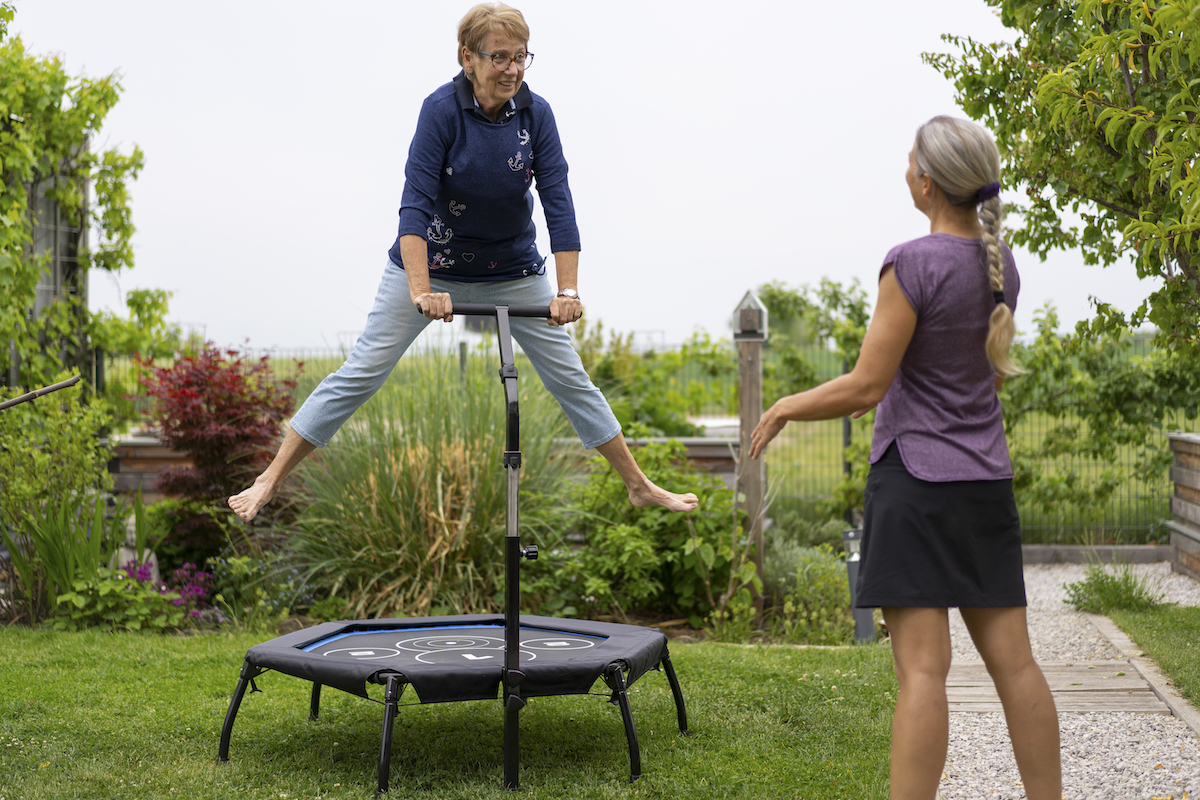What Is Rebounding—and Should You Try It?
This just might be the fun, effective workout you’ve been searching for.

A video of Goldie Hawn jumping on what looks like a mini trampoline went viral in 2020 after she posted it on Instagram with the caption, “Dance, jump and twirl like nobody’s watching.” The beloved actress, now 75, looked fantastic, fit, and, most important, like she was having an absolute blast.
Technically, Hawn’s workout is called “rebounding,” and her mini trampoline is a rebounder. Here’s what you need to know if you want to jump your way to health.
What Is Rebounding?
“I often describe rebounding as aerobics on a trampoline, with less impact on the joints,” says Nikki Hayes, a JumpSport Fitness Trampoline credentialed instructor based in Peru, Nebraska. It’s a great way to get your heart pumping and strengthen your muscles and bones, without the added pressure that activities like running or jumping on land put on your body.
Rebounders have a firm jumping mat, come in various diameters (40 inches is a popular size), and are great for home workouts, since they allow you to do cardio in a small space, no big machines required.
Unlike the giant trampolines of your childhood, when you rebound, you want to think about staying low and jumping into the mat, not jumping off it and trying to get high. The goal is to engage your core with every downward bounce.
“With each bounce, literally every muscle in your body contracts,” says Randi Kant, M.S., M.P.H., C.P.T., a certified Bellicon instructor and personal trainer in Chicago, as well as a wellness educator for Mather, a not-for-profit organization dedicated to healthy aging. “It’s extremely effective for strengthening your core and lower body muscles,” she says.
The Fun Factor of Rebounding
You can use a rebounder in a variety of ways, depending on your fitness level. Start with light bounces, during which your feet never even leave the mat, and progress to jumps, jumping jacks, jogging in place, and more.
When you initially try a rebounder, just standing on the unstable surface could be a challenge. You might have to work up to bouncing off the mat. A “closed chain bounce” keeps your feet in contact with the mat. Then progress to an “open chain bounce,” in which your feet do come off the mat. Upper-body exercises, such as a biceps curl, will also be more challenging because of the unstable surface. Combine bouncing and strength training for a great interval workout.
In addition to being suitable for all ages and levels of fitness and functional ability, one of the best parts of rebounding is that it’s fun, Kant says.
“In fitness, as in life, we bike and swim and run and step and climb, but we don’t really jump. And it seems like we should. Why do kids love bounce houses? There’s a fun factor,” she says. “Consequently, you’re not dreading your workout. You’re looking forward to it. And when you equate your workout with fun, you get a bigger bang for your buck. Plus, it just makes you feel happy. I feel an immediate sense of joy when I start to bounce.”
Kant points to research that shows that when people rebound, they get a moderate-to-intense cardiovascular workout that’s on par with running—but it’s perceived to be far easier, according to an American Council On Exercise (ACE) study.
“You’re basically getting more done with less perceived effort,” she says. But the perks don’t stop there.
3 Benefits of Rebounding for Older Adults
Besides feeling like a kid again, rebounding offers several science-backed benefits for older adults.
1. You’ll Build Stronger Bones
The main reason strength training helps boost bone health is that lifting dumbbells or doing squats places an increased load on your bones, and they respond by growing stronger. Jumping on the ground or running has a similar effect, stimulating new bone formation. Rebounding is equally effective, signaling bones to grow stronger, “but with a fraction of the stress on the musculoskeletal system,” Kant says.
One of Kant’s clients, age 69, had osteoporosis when she began a combination rebounding/strength-training program. She’s now regained enough bone mineral density to be classified as having osteopenia, meaning “she still has low bone mass but not so low that her bones will easily break,” Kant says. That’s real progress in a positive direction.
2. You’ll Boost Balance
Rebounding helps improve balance in older adults and reduces the likelihood of falling. In a 2019 Clinical Interventions in Aging study, women with low bone mass ranging in age from 56 to 83 were assigned to one of two groups. One group performed mini-trampoline exercises twice per week for 12 weeks, incorporating balance, strength, and jumping exercises, while the other group didn’t do any training. At the end of 12 weeks, researchers found that the rebounding workout was “highly effective” for improving balance and strength, and it reduced fear of falling.
“When you’re rebounding, every time you land, you’re essentially falling in a very controlled way,” Kant explains. “You go from having your feet off the jumping mat to landing, when you brace your core to generate stability.”
Jumping workouts also increase proprioception, which is your awareness of where your body is in space. And because it’s usually done barefoot, it strengthens the stabilizer muscles in the feet, ankles, calves, knees, and hips, says Chad Walding, D.P.T., a physical therapist in Austin, Texas, and co-founder of health-and-nutrition company NativePath.
3. You’ll Improve Cardiovascular and Overall Fitness
Like other forms of exercise, rebounding strengthens muscles, including the heart. A stronger heart is linked to lower blood pressure and a lower resting heart rate (meaning your heart doesn’t have to work as hard to do its job).
A recent German Journal of Sports Medicine study confirmed the positive impact of rebounding on fitness levels, including its ability to create what the researchers called “substantial aerobic intensity and energy expenditure”—which means it gets the heart pumping and burns calories.
In the study, three 19-minute rebounding workouts per week for eight weeks was enough to reduce the subjects’ body fat by 5.4 percent. While these results are promising, it’s important to remember that exercise is just one piece of the puzzle when you’re trying to lose weight—things like diet and stress management play an important role too.
Are There Any Potential Downsides?
While rebounding’s ability to improve your balance and proprioception can help reduce fall risk, there is also the possibility of falling off the rebounder while exercising.
To address this, many companies offer handles or balance bars to hold on to while rebounding, for extra security. It’s also a good idea to wear sneakers or purchase grippy nonslip socks, which let you reap the benefits of going barefoot while reducing the risk of slipping.
Another potential drawback: Some people, especially (but not only) women, may experience urine leakage while running, jumping, laughing, or sneezing. This is called stress incontinence, says Jill Hoefs, M.P.T., a women’s health physical therapist based in New Providence, New Jersey.
Working with a pelvic floor physical therapist can help strengthen the pelvic floor. Hoefs says that “strengthening the pelvic floor can help support the urethra and bladder, which can help prevent leakage.” For a short-term solution, women can try a bladder support (a nonabsorbent, tampon-like product that’s inserted into the vagina) or wear a super-plus tampon during physical activity.
“These products press against the urethra, slowing or preventing urine from dribbling out,” Hoefs says. You can also wear leakproof underwear, also called absorbent underwear (Google “pee-proof underwear”), which features innovative, antimicrobial, odor-resistant materials in the crotch that absorb several teaspoons’ worth of liquid while still feeling dry to the touch.
Subscribe to our newsletter
It's quick and easy. You could be one of the 13 million people who are eligible.
Already a member? Click to discover our 15,000+ participating locations.
Follow Us
Ready to Try Rebounding? Start Here.
As with any new exercise routine, it’s a good idea to talk with your doctor before you start rebounding. While it’s generally safe, it may not be appropriate if you’ve had previous surgeries, such as a joint replacement, or if you have other medical concerns.
If your doctor gives you the green light, Kant and Hayes offer these tips for purchasing a rebounder and getting started.
1. Skip Metal Springs in Favor of Bungee Cords
Some rebounders use metal springs to attach the mat to the frame; others use bungee cords. Both Kant and Hayes recommend choosing one that uses bungee cords. This makes for a smoother bounce, and it reduces the risk of painful pinches.
Also, any rebounder you buy should have sturdy, stable legs and a circumference between 36 and 48 inches. If you have balance problems (or just want extra support), look for a rebounder with a handlebar. Here are some highly rated options at various price points:
- Marcy Cardio Trampoline Trainer
- Sportplus Unisex Quiet Miniature Indoor Rebounder
- Darchen Mini Trampoline for Adults
- JumpSport 250 Fitness Trampoline
2. Start Slow and Progress Gradually to Build a Solid Foundation
Your initial goal is to get comfortable on the rebounder, so start small. Even just a few minutes at a time a few times a day is a great way to start.
Begin by standing on the mat, feet hip-width apart and a small bend in your knees. Hinge at your hips, bending forward slightly while your spine remains straight. With your core engaged (imagine pulling your belly button in toward your spine), start bouncing softly by lifting your heels only, keeping the balls of the feet on the mat. As you bounce, focus on pressing your feet into the mat, particularly the outside corner of your heels and the balls of your big and little toes.
This is called a down bounce, or a health bounce, and it’s the foundational movement of rebounding. Experiment with this movement for a few minutes, resting as needed.
Keep your core engaged to generate stability and balance while you’re on the rebounder. You may want to move your hands up in front of you for added balance—like what a tennis player does as they hold a racket in anticipation of returning a serve—or hold on to the support handles or T-bar, if available.
3. Find Free Beginner Rebounder Workouts on YouTube
As you start to feel comfortable on the rebounder, you can experiment with increased time and different movements. YouTube is a great place to find rebounder workouts when you’re ready. You can simply search for “beginner rebounder workout” and choose one of the results, or check out Hayes’s page, Earth & Owl. She offers beginner, intermediate, and advanced videos, including some starring her 86-year-old grandmother!
All in all, Kant says that rebounding is an ideal choice for seniors looking to switch up their fitness routine. “There’s nothing to plug in, no password, no screen, and for half the time you’re on it, gravity is eliminated,” she says. “It literally takes the weight of the world off your shoulders.”
Check Your SilverSneakers Eligibility Instantly
SilverSneakers members can go to thousands of gyms and fitness locations across the nation, plus take SilverSneakers LIVE online classes that are designed for seniors of all levels. If you have a Medicare plan, it may include SilverSneakers—at no additional cost. Check your eligibility instantly here.
Not eligible for SilverSneakers? You can still get 200+ free SilverSneakers On-Demand videos and stay in touch with us by creating an online account.





